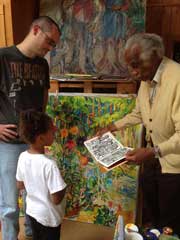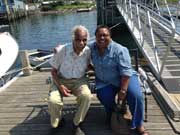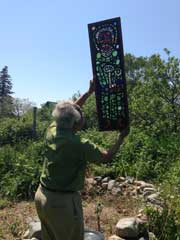Ashley Bryan Talks with Roger
Talks with Roger is a sponsored supplement to our free monthly e-newsletter, Notes from the Horn Book.

Talks with Roger is a sponsored supplement to our free monthly e-newsletter, Notes from the Horn Book. To receive Notes, sign up here.
Sponsored by![]()
 Ashley Bryan lives in the tiny — pop. 70 — town of Islesford on Little Cranberry Island, a part of Acadia National Park in coastal Maine. It's an inspiring setting indeed for Bryan's latest book, Sail Away: Poems by Langston Hughes, a collection of fifteen extremely child-friendly poems by the great writer, all devoted to themes of water and particularly the sea, and each one gloriously illustrated in sensuous cut-paper collage. Here are some highlights of my interview with Ashley Bryan via phone from his home (where he was entertaining Horn Book stalwarts Robin Smith and Dean Schneider, whose photos can be found below).
Ashley Bryan lives in the tiny — pop. 70 — town of Islesford on Little Cranberry Island, a part of Acadia National Park in coastal Maine. It's an inspiring setting indeed for Bryan's latest book, Sail Away: Poems by Langston Hughes, a collection of fifteen extremely child-friendly poems by the great writer, all devoted to themes of water and particularly the sea, and each one gloriously illustrated in sensuous cut-paper collage. Here are some highlights of my interview with Ashley Bryan via phone from his home (where he was entertaining Horn Book stalwarts Robin Smith and Dean Schneider, whose photos can be found below).Roger Sutton: I hope you're having a good summer.
Ashley Bryan: Yes. You know, summers are always special, because so many people I see only in the summertime come, and the island is so beautiful.
 RS: How much does the population increase in the summertime?
RS: How much does the population increase in the summertime?AB: It goes from seventy to about four or five hundred when the cottages around the shore are all occupied. And every day we have hundreds of people take the boat and come out to walk on an island.
RS: How do you like living with only sixty-nine other people for most of the year?
AB: Well, I've always loved community. It was that way in New York, Roger. Growing up in the twenties and thirties, we lived in tenement apartments, four or five stories, and we knew all the people in the building. Everyone looked after everyone. In good weather people would sit out on the street with their games and instruments and an eye on the children. So the feeling of community that I had growing up in New York is what I found on these small islands.
RS: How did you discover them?
AB: It was through a Skowhegan School of Art scholarship I received in 1946, the year the school [a summer residency program], was founded. I had just come back from the Second World War and was completing my work at the Cooper Union. I came back completely spun around by the war and wanting to find out why man chooses war. I knew I wanted to finish at Cooper Union, but I knew I had to try and find answers to my question, too. That very summer I came up to Skowhegan, and that's where I found my roots. Painting outdoors in the midst of the earth, the sky, the sea. I had such a strong feeling of nature and the care that nature asks of us and painting from the inspiration of what was in nature. On weekends we'd go to Acadia National Park, and you'd see all these islands off the shore. That's how I came to the Cranberry Isles. I knew that every summer that I was home in the States I would spend my time painting on those islands. I did sabbaticals there. So over the years, I grew to know not only the landscape, but the families, for generations.
When I was about to retire I chose to come here rather than returning to New York City, where all I had grown up with has been razed and made uniform — it's not a community any longer.
RS: Well, we can't afford it anymore anyway.
AB: Yeah. So I decided I'd live on this little island where not only did I know the people, but the people knew me. Everything that I do here people have taken part in. My work with painting, with sea glass, with making puppets—everything has been my outreach to the community, in the hopes that its few remaining year-round residents will be able to hold on.
 Horn Book reviewer Sam Bloom and his daughter visit Ashley Bryan. Photo: Robin Smith
Horn Book reviewer Sam Bloom and his daughter visit Ashley Bryan. Photo: Robin SmithRS: The art for this book is done in collage. What kind of a distinction do you make when you talk about painting and collage? Do you consider them the same thing, or are they different?
AB: To me it's all the same thing. As I was saying to Daniel Kany in a recent article in Kolaj magazine, my work in general is not divided into illustration or anything else. It is an urgency that is fundamental, and the essence is the same. It's the urgency to discover something about ourselves in every work we make. I make no distinction between doing a block print, a collage, a watercolor, a tempera painting. To me it's an effort to discover something of myself that I do not know and have not done. So each effort is like that of the child going out in the morning, making discoveries and having adventures.
RS: How do you compare the artistic process of cutting a piece of paper with putting paint onto a canvas? How is it the same and how is it different?
AB: Well, design is always at the heart of whatever you do, whether you're painting a scene of, say, a garden outdoors, or working on a collage. I'm starting with a blank surface. And I'm committing myself, by the first marks I make, to a continuity of rhythm that's going to create the composition. And for me, that kind of effort is a dialogue between the material and the artist, which is constant. It doesn't matter what I'm doing. If I'm walking the shore, and I pick up two shells, I put the shells together, and I say, "That reminds me of an African mask. I'm going to make a puppet of that." It's seeing a material that you're going to transform. And that is universal. It's integral to everything we do. The act of transformation and the desire to transform.
RS: And how much do you know before you start cutting?
AB: I try to know nothing about anything in the art that I am about to begin. What I already know is wonderful. There will always be that biography following me. But I don't want to do what I have already done or already know. I want to make a discovery. So I say to myself, "I must find something in this adventure that I've never had before." Yes, there will be a family resemblance in the creation. But I want to make that discovery of what I do not know through the adventure of the work.
People have said "Sail Away is the best work you've done." Well, that's fine. I like to feel that whatever I do, that it is the best. But it's all in company, a family relationship to everything else I have done. I can respect and love what I've done in the past, and I can look back surprised at what I did when I was fifteen, twenty, all of which is currently in an exhibit of my life and art at a museum up here.
 Ashley Bryan and Deborah Taylor on the dock. Photo: Robin Smith
Ashley Bryan and Deborah Taylor on the dock. Photo: Robin SmithRS: How did you select the poems for Sail Away?
AB: The poems that I selected from Langston Hughes were ones I felt a child would have no trouble immersing him- or herself in. To me, those poems would be like Stevenson's A Child's Garden of Verses, Eugene Field's Poems of Childhood, Mother Goose rhymes. The freshness, the sense of the child…that would relate to all children. I had a vast range of Hughes poems to choose from.
Through poetry we find this confrontation with the most difficult and the most joyous things to face in life.
And so when I take a poem by Langston Hughes, there is a kind of brilliance. Nikki Giovanni, a living artist today who I know and love, gives me that same sense in the way she explores language and excites the spirit through language. That kind of inspiration just lives with me, which is why I dedicated the book to her and Langston, out of that little poem of Langston Hughes's, "To Make Words Sing." "To make words sing / Is a wonderful thing— / Because in a song / Words last so long." You can remember the strains of a poem that will never leave you. And it does not matter how many hundreds of years ago it might have been written or how recently. It is always current to you.
RS: Do you remember when you discovered Langston Hughes?
AB: I was on my own in that, because it was not a part of my schooling growing up in the Bronx. My finding of black artists was on my own. We had the basics — you know, George Washington Carver. But Langston Hughes was not included, nor Countee Cullen, or any of the black American poets. I discovered them later through my love of poetry — Keats, Shelley, Wordsworth, Emily Dickinson, Frost, Sandburg. But finding black artists, for most young people in school in our country, is a search of their own. It is not a part of the curriculum. It is not required. It is not on any exams. And it is considered something that's an addition for Black History Month, something which can be forgotten because it will not be on the test.
RS: When you're illustrating a poem, do you hear it in your head as you create?
AB: Oh, it sings through me constantly, in waking and sleeping. I'm listening, I'm singing it. The motion of it. Each poem that I take on has the depth of a world, feeling and thinking and rhythm. "Off the coast of Ireland / As our ship passed by / We saw a line of fishing ships / Etched against the sky. // Off the coast of England / As we rode the foam / We saw an Indian merchantman / Coming home." There's a feeling I wanted to get into the artwork as well, the spirit of excitement, of just being on the sea, with that line of fishing ships.
 The artist in nature. Photo: Robin Smith
The artist in nature. Photo: Robin SmithRS: It's interesting, as I look at that picture as you read the poem aloud, I see these strong horizontal and strong vertical lines meeting in just the way that you read. It's like the picture is marching, almost.
AB: Yes. Good. But in each poem, there are different images — and they change so profoundly. In "Sea Calm," for instance, that one with the very quiet water scene, the person's lying on the shore with a little child, and it's so simple. "How still, / How strangely still / The water is today. / It is not good / For water / To be so still that way." It's something you'd like someone to look at and reflect on, and almost enter into a dream of observation as they look at it, you know.
RS: I think that's what you want to do. You want to be careful in illustrating poetry not to be too directive. You know what I mean? You don't want to simply recreate what the poem says.
AB: You want to give an echo of image that can allow for a wandering experience of the seer, so that they can bring something of themselves to it as well.
RS: Don't you think that poem "Sea Calm" is kind of creepy? I don't mean that in a bad way.
AB: Yes, it is strange, but it's open for people to respond to it their own way. Very often, when I'm crossing back and forth from my island to the mainland, I'm looking at the surface of the ocean. And I'll just be thinking of the Middle Passage, what the depths of that very still surface of the water has meant to my people, crossing from Africa to our hemisphere, the New World. The sea is always beautiful. But you know what it can mean, if anything happens to the ship. A sudden storm where fishermen are swept away and lost. When they started out on a day that seemed a fishing day, and then suddenly a storm comes up, and they're swept away. Or your power dies. It's a winter day. And you're found washed up, your boat on the shore, frozen against the motor that you've huddled over for warmth. When I came here to the islands, in the late forties and fifties, I had some experiences like that, you see. This sea that Langston Hughes loved — he calls his autobiography The Big Sea. The sea is mysterious. It's beautiful and people like it. But that wide, deep depth is also very holding.
RS: Well, I wonder if that's part of what keeps us attracted to it — knowing the terror that it holds, as well as the beauty. We can't look away from it.
AB: I remember visiting the family home in Antigua, in the West Indies. As a young man I wanted to see where my parents had come from. And at that time I would go snorkeling. I would be looking at all these different corridors of fish below, and I would suddenly forget that I'm in water. And I'd have to keep coming back, that I'm being buoyed up by the water as I'm experiencing the rhythm and movement of fish below. It's amazing — seventy percent or so of the earth is water, so it's bound to be very much a part of the language and the lives of people.
RS: I think that is a perfect place for us to stop. I got you at your most poetic.
More on Ashley Bryan from The Horn Book
- Coretta Scott King-Virginia Hamilton Lifetime Achievement Award Acceptance
- Wilder Medal Acceptance
- Profile of Wilder Medal winner Ashley Bryan
- Reviews of select books by Ashley Bryan
Sponsored by![]()
RECOMMENDED
ALREADY A SUBSCRIBER? LOG IN
We are currently offering this content for free. Sign up now to activate your personal profile, where you can save articles for future viewing.







Add Comment :-
Comment Policy:
Comment should not be empty !!!
Hadassah Tannor
You continue to amaze me with your versatility as an artist and the sheer beauty of your illustrations.I am reviewing "Sail Away" and your selection of poems are not only child-friendly but have emotions power that can raise the reader's awareness of the natural world. I was at Dalton while you were there teaching in the pre-school program in the early 60's. I also spent many summers near Skowhegan at Camp Modin in Canaan, Maine. My love of nature is a result of those wonderful years. Hadassah TannorPosted : Oct 28, 2015 03:46